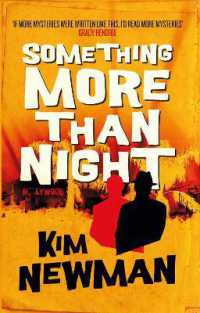Full Description
Multidisciplinary scholarship showcasing innovative methods for working with sculptural material - with essays ranging from Merovingian funerary art to Old English and Scandinavian runic inscriptions.
The stone sculptures surviving across Europe from the early medieval period are an exceptional resource for understanding the communities that created them. Found at waysides, in architectural settings, and graveyards - standing crosses, inscribed stones, runestones and grave-markers are just some of the highly varied forms that attest to the art, technologies and beliefs of both Christian and non-Christian societies. The new approaches to sculpture studies found in this volume range from rethinking late antique influences to exploring how sculpture was used and encountered in a variety of political and cultural contexts; contributors also draw out the dialogues inherent in form and decoration within and across temporal and national boundaries. These fresh perspectives on iconographies, narrative art, sculpture and nature and the power of sculpture in multi-media environments, alongside studies of sourcing, production and portability, and the afterlives of carved stones, reflect the vibrancy of current research and the way in which it now integrates digital, scientific and spatial methods.
The introduction and chapters 26 and 27 are available as Open Access under the Creative Commons licence CC BY-NC-ND. This work was supported by the Arts and Humanities Research Council [AH/R003556/1] and the British Academy [AQ2324\240012].
Chapter 17 is Open Access under the Creative Commons License CC BY-NC-ND with funding from the Swedish National Heritage Board.
Contents
List of Illustrations
Preface
List of Abbreviations
Note on Terminology
I. Context
1. Introduction. Early Medieval Sculpture in Stone
By Sarah Semple and Jane Hawkes [Open Access]
2. Tales of Sculptures and Scholarships
By Jane Hawkes
II. Sculpture at Scale: supra-regional to local contexts
3. Carved Monuments and Political Actors in Britain AD 400-1100
By Martin Carver
4. Early Medieval Sculpture in its International Context: the Pictish Symbol Tradition of Early Medieval Scotland
By Gordon Noble and Martin Goldberg
5. Barrow and Cairn Cemeteries and Symbol Stones: Constructing Monumental Landscapes in Fifth- to Seventh-Century Pictland
By Juliette S. Mitchell
6. Design and Influence in Early Inscribed Stones in Britain and Ireland
By David Petts
7. Sculpture on Man and the Isles: An Iconographic Examination of Ecclesiastical Networks Across the Irish Sea
By Heidi Stoner
III. Rethinking lapidary sculptures
8. Northumbrian Lapidary Inscriptions and the Vikings
By David N. Parsons
9. Why Include an Inscription on an Anglo-Saxon Sculptured Stone Monument?
By Elisabeth Okasha
10. Having the Dead in Hand: Movement, Display and the Northumbrian Name Stones
By Jill Hamilton Clements
IV. Multi-valent sculptures
11. On the Edge of Pictish Relief
By Luke A. Fidler
12. Life in Stone
By Catherine E. Karkov
13. Ritual and Reuse: Early Baptismal Fonts of the Medieval West
By Carolyn Twomey
14. Cross-slab to High-Cross: Understanding the Early Medieval Sculptural Remains at Carndonagh, Co. Donegal
By Megan Henvey
15. Cloud Watching in Northumbria: Toward a Phenomenology of Early Medieval Stone and Landscape
By Meg Boulton
V. Scandinavian perspectives
16. Rune Stones, Picture Stones, and other Erected Stones in Scandinavia, c. 400-1100
By Anders Andrén
17. An introduction to the project "Ancient Images 2.0": Creating an Online Edition of Gotland's Picture Stones
By Laila Kitzler Åhfeldt and Sigmund Oehrl [Open Access]
VI. Making and meaning
18. Delving and distributing: where does the stone come from?
By Paul Everson and David Stocker
19. New Cross-Components from Lindisfarne, Northumberland.
By Christina Smith
20. The Virgin with the Book at Breedon on the Hill, Leicestershire
By Francesca Dell'Acqua
21. Beyond a Grammar of Ornament: the Language of Visual Narratives
By Lilla Kopár
22. At Cross Purposes? The Sacred and Secular Figural Iconographies of Anglo-Scandinavian Stone Crosses
By Amanda Doviak
23. Celebration of the 'Special Dead', at St Gregory's Minister, Kirkdale, North Yorkshire
By Lorna Watts
VII. Commodification
24. An Example of Merovingian Funerary Art in Gaul: The Sarcophagi Lids Decorated with a Multiple Bands Motif from Poitou
By Daniel Morleghem, Anne Flammin and Guillaume Rougé
25. Monuments and Merchants
By Paul Everson and David Stocker
26. 'Isolated Memorials'? A new free-standing cross from Reymerston, Norfolk, in context
By Sarah Semple, Tudor Skinner, Christina Smith, Derek Craig and Paul Stamper [Open Access]
VIII. Looking ahead
27. Stone Sculpture: Futures
By Sarah Semple, Tudor Skinner, Zeynap Aki, Megan Kasten, Roger Lang and Jordyn Patrick [Open Access]
List of Contributors
Bibliography
Index








